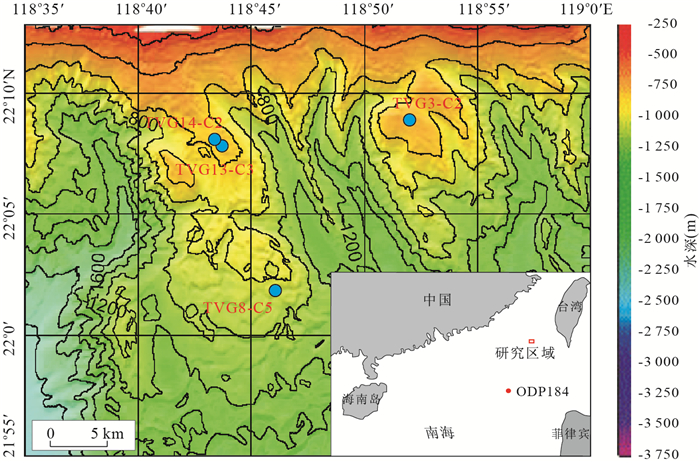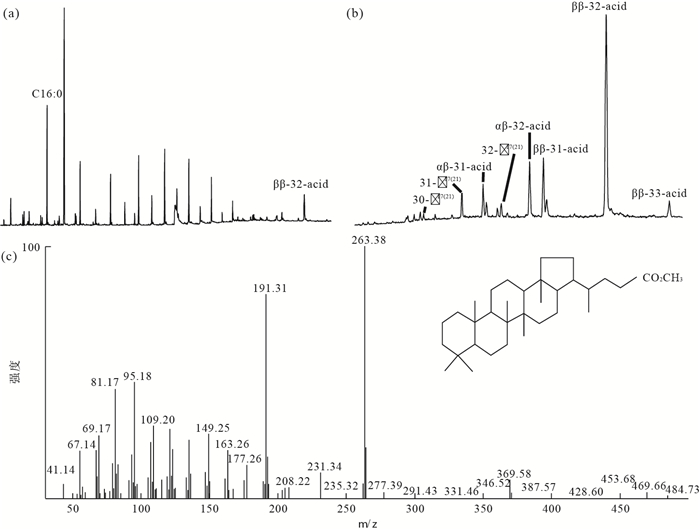Hopanoid Acids and Their Geochemistry Significance Detected in Seep Carbonates from the South China Sea Continental Slope
-
摘要: 对南海东沙海域九龙甲烷礁冷泉碳酸盐岩的藿烷酸系列化合物进行了研究, 结果显示冷泉碳酸盐岩中含有17β(H), 21β(H)-30-藿烷酸至17β(H), 21β(H)-33-藿烷酸系列化合物. 其中site1样品TVG3-C2(ANME-2古菌种群为主)中的17β(H), 21β(H)-32-藿烷酸化合物亏损13C(-69.8‰), 且其同位素值较接近iso-/aiso-C15:0脂肪酸(-75.2‰~-90.0‰), 说明其母质摄入了甲烷来源的碳.尽管site2(TVG13-C3和TVG14-C2)和site3(TVG8-C5)自生碳酸盐岩中藿烷酸化合物都表现出了非渗漏特征(-30.7‰~-40.3‰, ANME-1古菌种群为主), 但这些样品中藿烷酸的δ13C值同样较接近硫酸盐还原菌来源的iso-/anteiso-C15:0的δ13C值(-32.5‰~-49.8‰).由此说明大多数存在于以ANME-1种群为主的渗漏环境中的硫酸盐还原菌并没有参与到甲烷厌氧氧化作用中, 而导致藿烷酸化合物和硫酸盐还原菌来源的生物标志物并不明显亏损13C, 并且δ13C值相近.Abstract: The lipid biomarkers of hopanoid acids in cold seep carbonates from the South China Sea continental slope are investigated. In the hopanoid acids, 17β(H), 21β(H)-30-hopanoid acid-17β(H), 21β(H)-33-hopanoid acid are identified with 17β(H), 21β(H)-32-hopanoid acid being the most aboundant. The 17β(H), 21β(H)-32-hopanoic acid depleted in 13C and the δ13C value(-69.8‰) fall close to the range of SRB (sulfate-reducing bacteria)-derived iso-/anteiso-C15:0 (-75.2‰ to -90.0‰) in site1 seep carbonate(TVG3-C2, ANME-2 dominated), suggesting the incorporation of methane-derived carbon. Although they show non-seep isotopic signatures (-30.7‰ to -40.3‰, ANME-1 dominated) in site3 (TVG8-C5) and site2 seep carbonates (TVG13-C3 and TVG14-C2), hopanoids δ13C values fall close to the range of SRB-derived iso-/anteiso-C15:0 (-32.5‰ to -49.8‰). The majority of SRB are not involved in AOM (anaerobic oxidization of methane) possibly because ANME-1 cells often occur as monospecific aggregates.
-
Key words:
- hopanoic acids /
- methanotrophy /
- seep carbonates /
- Jiulong methane reef /
- microorganisms /
- geochemistry
-
图 2 TVG8-C5酸类化合物总离子流(a)、m/z191离子流(b)和样品中ββ-32-藿烷酸化合物质谱(c)
31-Δ17(21)为C31Δ17(21)藿烯酸,ββ-32-acid为17β(H),21β(H)-32-藿烷酸
Fig. 2. Total ion chromatogram (TIC) of the carboxylic acid fraction of TVG8-C5 (a); the m/z 191 chromatograms of methyl esters of hopanoic acids in sample TVG8-C5 (b); the mass spectrum of 17β(H), 21β(H)-32-hopanoic acid (c)
表 1 南海北部陆坡冷泉碳酸盐岩采样信息
Table 1. Locations of seep carbonates from the northern slope of the South China Sea
位置 年份-航次编号 纬度N 经度E 水深(m) site1 TVG3-C2 2004-SO-177-1 22°08.98′ 118°52.34′ 473 site3 TVG13- C3 2004-SO-177-2 22°08.54′ 118°43.45′ 555 TVG14-C2 2004-SO-177-1 22°08.63′ 118°43.39′ 533 site2 TVG8-C5 2004-SO-177-1 22°02.85′ 118°46.55′ 769 表 2 藿烷酸化合物碳同位素组成及环境中主导种群
Table 2. The carbon composition of the hopanoid acids and the dominant archaeal consortia consortium in cold seep settings
样品编号 αβ-C32-hopanoic acid ββ-C32-hopanoic acid iso-C15:0 aiso-C15:0 主导微生物种群 参考文献 δ13C(‰)(V-PDB) δ13C(‰)(V-PDB) δ13C(‰)(V-PDB) δ13C(‰)(V-PDB) TVG3-C2 tr -69.8 -90 -75.2 ANME-2 TVG8-C5 tr -40.3 -38.9 -41.5 ANME-1 TVG13-C3 tr -30.7 -45.2 -49.8 ANME-1 TVG14-C2 tr -32.9 -32.5 -35.5 ANME-1 Cozzo Disi -87 -83 -53 ANME-2 Ziegenbalg et al.(2012) Gaspa-1 -52 -77 -80 -68 ANME-2 Ziegenbalg et al.(2012) Monticino -31 -33 -27 ANME-1 Ziegenbalg et al.(2012) -
Alberts, B., Johnson, A., Lewis, J., et al., 2002. Molecular Biology of the Cell(4). Garland Publishing, Inc., New York. Birgel, D., Feng, D., Roberts, H.H., et al., 2011. Changing Redox Conditions at Cold Seeps as Revealed by Authigenic Carbonates from Alaminos Canyon, Northern Gulf of Mexico. Chemical Geology, 285(1-4): 82-96. doi: 10.1016/j.chemgeo.2011.03.004 Birgel, D., Peckmann, J., 2008. Aerobic Methanotrophy at Ancient Marine Methane Seeps: Asynthesis. Organic Geochemistry, 39(12): 1659-1667. doi: 10.1016/j.orggeochem.2008.01.023 Birgel, D., Thiel, V., Hinrichs, K.U., et al., 2006. Lipid Biomarker Patterns of Methane-Seep Microbialites from the Mesozoic Convergent Margin of California. Organic Geochemistry, 37(10): 1289-1302. doi: 10.1016/j.orggeochem.2006.02.004 Blumenberg, M., Krüger, M., Nauhaus, K., et al., 2006. Biosynthesis of Hopanoids by Sulfate-Reducing Bacteria(Genus Desulfovibrio). Environmental Microbiology, 8(7): 1220-1227. doi: 10.1111/j.1462-2920.2006.01014.x Blumenberg, M., Seifert, R., Reitner, J., et al., 2004. Membrane Lipid Patterns Typify Distinct Anaerobic Methanotrophic Consortia. PNAS, 101(30): 11111-11116. doi: 10.1073/pnas.0401188101 Boetius, A., Ravenschlag, K., Schubert, C.J., et al., 2000. A Marine Microbial Consortium Apparently Mediating Anaerobic Oxidation of Methane. Nature, 407: 623-626. doi: 10.1038/35036572 Bouloubassi, I., Aloisi, G., Pancost, R.D., et al., 2006. Archaeal and Bacterial Lipids in Authigenic Carbonate Crusts from Eastern Mediterranean Mud Volcanoes. Organic Geochemistry, 37(4): 484-500. doi: 10.1016/j.orggeochem.2005.11.005 Brocks, J.J., Pearson, A., 2005. Building the Biomarker Tree of Life. Reviews in Mineralogy and Geochemistry, 59(1): 233-258. doi: 10.2138/rmg.2005.59.10 Farrimond, P., Griffiths, T., Evdokiadis, E., 2002. Hopanoic Acids in Mesozoic Sedimentary Rocks: Their Origin and Relationship with Hopanes. Organic Geochemistry, 33(8): 965-977. doi: 10.1016/S0146-6380(02)00059-1 Guan, H.X., Sun, Y., Zhu, X., 2013. Factors Controlling the Types of Microbial Consortia in Cold-Seep Environments: A Molecular and Isotopic Investigation of Authigenic Carbonates from the South China Sea. Chemical Geology, 354: 55-64. doi: 10.1016/j.chemgeo.2013.06.016 Han, X., Suess, E., Huang, Y., et al., 2008. Jiulong Methane Reef: Microbial Mediation of Seep Carbonates in the South China Sea. Marine Geology, 249 (3-4) : 243-256. doi: 10.1016/j.margeo.2007.11.012 Hinrichs, K.U., Boetius, A., 2003. The Anaerobic Oxidation of Methane. In: Wefer, G., Billett, D., Hebbeln, D., eds., Ocean Margin Systems. Springer-Verlag, 457-477. Hiroyuki, S., Noriyuki, S., 2007. Distributions and Sources of Hopanes, Hopanoic Acids and Hopanols in Miocene to Recent Sediments from ODP Leg 190, Nankai Trough. Org. Geochemistry, 38(10): 1715-1728. doi: 10.1016/j.orggeochem.2007.05.012 Innes, H.E., Bishop, A.N., Fox, P.A., et al., 1998. Early Diagenesis of Bacterio-hopanoids in Recent Sediments of Lake Pollen, Norway. Organic Geochemistry, 29(5-7): 1285-1295. doi: 10.1016/S0146-6380(98)00108-9 Innes, H.E., Bishop, A.N., Head, I.M., et al., 1997. Preservation and Diagenesis of Hopanoids in Recent Lacustrine Sediments of Priest Pot, England. Organic Geochemistry, 26(9-10): 565-576. doi: 10.1016/S0146-6380(97)00017-X Knittel, K., Boetius, A., Lemke, A., et al., 2003. Activity, Distribution, and Diversity of Sulfate Reducers and Other Bacteria in Sediments above Gas Hydrate (Cascadia Margin, Oregon). Geomicrobiology Journal, 20(4): 269-294. doi: 10.1080/01490450303896 Knittel, K., Loekann, T., Boetius, A., et al., 2005. Diversity and Distribution of Methanotrophic Archaea at Cold Seeps. Applied and Environmental Microbiology, 71(1): 467-479. doi: 10.1128/AEM.71.1.467-479.2005 Losekann, T., Knittel, K., Nadalig, T., et al., 2007. Diversity and Abundance of Aerobic and Anaerobic Methane Oxidizers at the Haakon Mosby Mud Volcano, Barents Sea. Applied and Environmental Microbiology, 73(10): 3348-3362. doi: 10.1128/AEM.00016-07 Michaelis, W., Seifert, R., Nauhaus, K., et al., 2002. Microbial Reefs in the Black Sea Fueled by Anaerobic Methane Oxidation. Science, 297(5583): 1013-1015. doi: 10.1126/science.1072502 Nauhaus, K., Treude, T., Boetius, A., et al., 2005. Environmental Regulation of the Anaerobic Oxidation of Methane: A Comparison of ANME-Ⅰ and ANME-Ⅱ Communities. Environmental Microbiology, 7(1): 98-106. doi: 10.1111/j.1462-2920.2004.00669.x Niemann, H., Duarte, J., Hensen, C., et al., 2006. Microbial Methane Turnover at Mud Volcanoes of the Gulf of Cadiz. Geochimica et Cosmochimica Acta, 70(21): 5336-5355. doi: 10.1016/j.gca.2006.08.010 Orphan, V.J., Hinrichs, K.U., Ussler, W., et al., 2001. Comparative Analysis of Methaneoxidizing Archaea and Sulfate-Reducing Bacteria in Anoxic Marine Sediments. Applied and Environmental Microbiology, 67(4): 1922-1934. doi: 10.1128/AEM.67.4.1922-1934.2001 Orphan, V.J., House, C.H., Hinrichs, K.U., et al., 2002. Multiple Archaeal Groups Mediate Methane Oxidation in Anoxic Cold Seep Sediments. PNAS, 99(11): 7663-7668. doi: 10.1073/pnas.072210299 Pancost, R.D., Chopmans, E., Sinninghe, J.S., 2001. Archaeal Lipids in Mediterranean Cold Seeps: Molecular Proxies for Anaerobic Methane Oxidation. Geochimica et Cosmochimica Acta, 65(10): 1611-1627. doi: 10.1016/S0016-7037(00)00562-7 Pancost, R.D., Sinninghe Damsté, J.S., de Lint, S., et al., 2000. Biomarker Evidence for Widespread Anaerobic Methane Oxidation in Mediterranean Sediments by a Consortium of Methanogenic Archaea and Bacteria. Applied and Environmental Microbiology, 66(3): 1126-1132. doi: 10.1128/AEM.66.3.1126-1132.2000 Pape, T., Blumenberg, M., Seifert, R., et al., 2005. Lipid Geochemistry of Methane-Seep-Related Black Sea Carbonates. Palaeogeography, Palaeoclimatology, Palaeoecology, 227(1-3): 31-47. doi: 10.1016/j.palaeo.2005.04.030 Pautot, G., Rangin, C., Briais, A., et al., 1986. Spreading Direction in the Central South China Sea. Nature, 321: 150-154. doi: 10.1038/321150a0 Peckmann, J., Thiel, V., Reitner, J., et al., 2004. A Microbial Mat of a Large Sulfur Bacterium Preserved in a Miocene Methane-Seep Limestone. Geomicrobiology Journal, 21(4): 247-255. doi: 10.1080/01490450490438757 Qu, D.C., Shi, J.Y., Xiang, M.J., 1996. The Identification and Significance of Two New Hopanoic Acid. Chinese Science Bulletin, 41(8): 731-734 (in Chinese). doi: 10.1360/csb1996-41-8-731 Quirk, M.M., Wardroper, A.M.K., Wheatley, R.E., 1984. Extended Hopanoids in Peat Environments. Chemical Geology, 42(1-4): 25-43. doi: 10.1016/0009-2541(84)90003-2 Reeburgh, W.S., 1976. Methane Consumption in Cariaco Trench Waters and Sediments. Earth and Planetary Science Letters, 28(3): 337-344. doi: 10.1016/0012-821X(76)90195-3 Reeburgh, W.S., 1980. Anaerobic Methane Oxidation: Rate Depth Distributions in Skan Bay Sediments. Earth and Planetary Science Letters, 47(3): 345- 352. doi: 10.1016/0012-821X(80)90021-7 Reeburgh, W.S., 1996. "Soft Spots" in the Global Methane Budget. In: Lidstrom, M.E., Tabita, F.R., eds., Microbial Growth on C1 Compounds. Kluwer Academic Publishers, Dordrecht, The Netherlands, 334-342. doi:10.1007/978-94-009-0213-8_44 Reeburgh, W.S., Whalen, S.C., Alperin, M.J., 1993. In Microbial Growth on C1 Compounds. In: Murrell, J.C., Kelly, P.D., eds., Proceedings of the 7th International Symposium. Am. Soc. Microbiol., Washington, D.C., 1-14. Ritger, S., Carson, B., Suess, E., 1987. Methane-Derived Authigenic Carbonates Formed by Subduction-Induced Pore-Water Expulsion along the Oregon/Washington Margin. Geological Society of America Bulletin, 98(2): 147- 156. doi:10.1130/0016-7606(1987)98<147:MACFBS>2.0.CO;2 Rohmer, M., Bisseret, P., Neunlist S., 1992. The Hopanoids, Prokaryotic Triterpenoids and Precursors of Ubiquitous Molecular Fossils. In: Moldowan, J.M., Albrecht, P., Philp, R.P., eds., Biological Markers in Sediments and Petroleum. Prentice Hall, London, 1-17. Rohmer, M., Bouvier-Nave, P., Ourisson, G., 1984. Distribution of Hopanoid Triterpenes in Prokaryotes. Journal of General Microbiology, 130(5): 1137-1150. doi: 10.1099/00221287-130-5-1137 Sinninghe Damsté, J.S., Rijpstra, W.I.C., Schouten, S., et al., 2004. The Occurrence of Hopanoids in Planctomycetes: Implications for the Sedimentary Biomarker Record. Organic Geochemistry, 35(5): 561-566. doi: 10.1016/j.orggeochem.2004.01.013 Taylor, B., Hayes, D.E., 1980. The Tectonic Evolution of the South China Basin. In: Hayes, D.E., ed., Tectonic and Geologic Evolution of Southeast Asian Seas and Islands. Geophys. Monogr., 23. American Geophysical Union, Washington, D.C., 89-104. Wang, P.R., 2001. Geochemistry and Application of Nonhydrocarbons. Petroleum Industry Press, Beijing, 50-52 (in Chinese). Wang, P.R., Yao, H.X., Chen, Q., et al., 1995. Compositional Characteristics of Organic Oxygen Compounds in Extract from Yimin Brown Coal. Journal of Jianghan Petroleum Institute, 17(2): 33-38 (in Chinese with English abstract). Watson, D.F., Farrimond, P., 2000. Novel Polyfunctionalised Geohopanoids in a Recent Lacustrine Sediment (Priest Pot, UK). Organic Geochemistry, 31(11): 1247-1252. doi: 10.1016/S0146-638000)00148-0 Zhou, Y.P., Shi, J.Y., Qu, D.C., 1999. Study on the Origin of ββ Hopenes from Different Depositional Environment—Stable Carbon Isotopic Evidences. Journal of South China Normal University (Natural Science), (3): 53-58(in Chinese with English abstract). Ziegenbalg, S.B., Birgel, D., Hoffmann-Sell, L., et al., 2012. Anaerobic Oxidation of Methane in Hypersaline Messinian Environments Revealed by 13C-Depleted Molecular Fossils. Chemical Geology, 292-293(13): 140-148. doi: 10.1016/j.chemgeo.2011.11.024 屈定创, 史继扬, 向明菊, 1996. 两类新的藿酸化合物的发现及其意义. 科学通报, 41(8): 731-734. doi: 10.3321/j.issn:0023-074X.1996.08.017 王培荣, 2001. 非烃地球化学和应用. 北京: 石油工业出版社, 50-52. 王培荣, 姚焕新, 陈奇, 等, 1995. 伊敏湖底褐煤抽提物中有机氧化合物的组成特征. 江汉石油学院学报, 17 (2): 33-38. https://www.cnki.com.cn/Article/CJFDTOTAL-JHSX502.005.htm 周友平, 史继扬, 屈定创, 1999. 沉积有机质中ββ藿烷成因研究——碳稳定同位素证据. 华南师范大学学报, (3): 53-58. doi: 10.3969/j.issn.1000-5463.1999.03.011 -










 下载:
下载:




